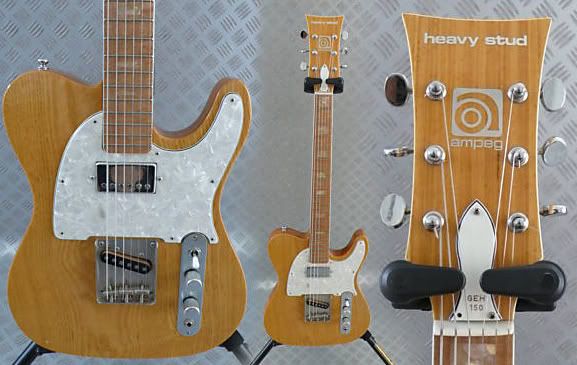
Tuesday, 30 September 2008
Ampeg T-style guitar

Monday, 29 September 2008
Guitar Weekends - Rock Weekend in Cumbria
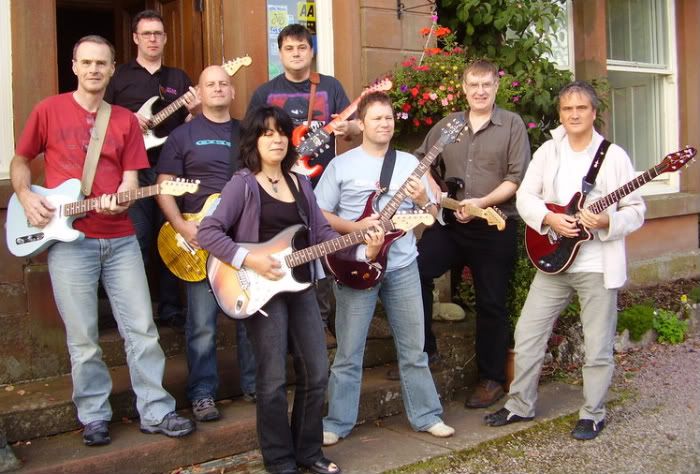
Guitar Weekends - Rock Weekend group 26-28 September 2008. L-R: Iain, Gary Dunn, Tony, Yours Truly, Rachel, Mark, Gordon and Graham
On Friday morning, I took the train up north and by mid-afternoon found myself at Beckfoot House near Penrith in Cumbria. I was there for one of the Guitar Weekends that Malcolm and Lesley White at Beckfoot House run throughout the year. Now I'd been on one of these before back in early 2007. That time it was an "Improvers" weekend, albeit with a rock flavour. I had a great time on that occasion but wanted to return so as to brush up on some of the theory. The weekend I chose this time also had a "rock" theme, but it turned out that it was actually a much more advanced course.
By mid to late afternoon a group of seven of us had assembled with our guitars and other paraphenalia and after introductions, Malcolm led us through a few exercises where we looked at scales and some alternative chord shapes. As a group we played through a few songs several times with Malcolm explaining how we could improve things by sharpening up our timing and by paying attention to the rhythm patterns.
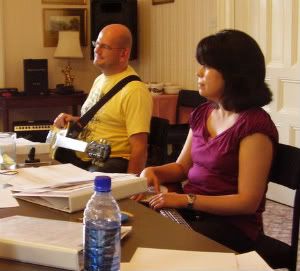 After an excellent dinner, we took it turns to play solos using the various scales relevant to the key the song was in. Everyone was put on the spot for a few moments when we were each asked to play something for the rest of the group. That was quite nerve-wracking but a good way to break the ice - a few of us fudged our playing, but no matter, we were all in the same boat. We went on playing until 1AM. Despite not starting until late afternoon, it had been a very busy day.
After an excellent dinner, we took it turns to play solos using the various scales relevant to the key the song was in. Everyone was put on the spot for a few moments when we were each asked to play something for the rest of the group. That was quite nerve-wracking but a good way to break the ice - a few of us fudged our playing, but no matter, we were all in the same boat. We went on playing until 1AM. Despite not starting until late afternoon, it had been a very busy day.But Malcolm was only the warm-up man. From Saturday morning Gary Dunn took over as our teacher. A softly-spoken Geordie with a great sense of humour and a helluva lot of patience, Gary is an excellent musician and a fantastic teacher, explaining and demonstrating everything clearly. We studied some theory, such as how chords are constructed, what notes appear in different keys and why. As on the previous day, we played through a number of songs and took turns to play solos. We spent some time looking at AC/DC's "Back In Black", breaking it down into its component riffs, and then combining them into a whole. I have to confess that I was finding some of this very tricky. The theory I could follow, but the putting it into practice was something else! However, I made plenty of notes for practicing later at home.
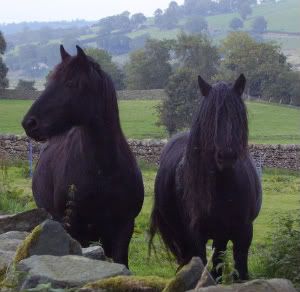 Late Saturday afternoon we had a break before dinner, so a group of us took a walk out into the beautiful surrounding countryside (and nearly getting ourselves lost, which is what happens when you start climbing walls and fences and marching over fields). This was a great opportunity to socialise and get to know each other better.
Late Saturday afternoon we had a break before dinner, so a group of us took a walk out into the beautiful surrounding countryside (and nearly getting ourselves lost, which is what happens when you start climbing walls and fences and marching over fields). This was a great opportunity to socialise and get to know each other better.After another one of Lesley's excellent dinners, we began our project for the night. We split into two groups, each being given a song to work on, arrange, practice and finally perform. My group had "Riders on the Storm" which we had to arrange for four guitars. Luckily it's a song with several intertwining guitar parts, so there was something for each of us to do. My main job was the rhythm guitar, but they weren't letting me off that easily and it was decided that each of us would take a solo, so whilst I soloed someone else had to take over the rhythm. One of our group, Iain, was persuaded to sing, which was a nice touch.
After about three hours of arranging and practicing our parts, both groups came back together and performed our respective songs for one another and these were recorded so we could listen back to our triumphs and mistakes! We were quite pleased with our "Riders" although unfortunately Tony's Les Paul chose to develop a jack-socket fault just as he was about to start his solo so that we had a crackle-crackle-crackle solo for a few moments before he was to get stuck in properly.
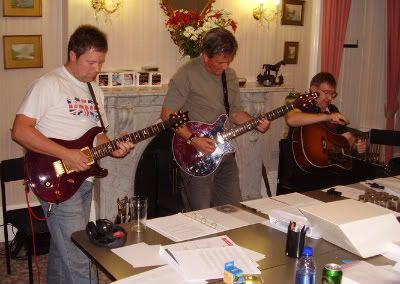 Rachel came out with a fantastic lead sound on her solo which caused a few heads to turn. I'm afraid I fluffed mine a little bit (although it wasn't that bad) but my main problem was that I hadn't set my relative rhythm versus lead volumes quite right and I was just too damn quiet. Iain having finished the vocals brought the song to a close with a nice solo on his Tele.
Rachel came out with a fantastic lead sound on her solo which caused a few heads to turn. I'm afraid I fluffed mine a little bit (although it wasn't that bad) but my main problem was that I hadn't set my relative rhythm versus lead volumes quite right and I was just too damn quiet. Iain having finished the vocals brought the song to a close with a nice solo on his Tele.Then it was Mark, Graham and Gordon's turn, and they got up and performed Santana's "Samba Pa Ti" ("This isn't just any food. This is Marks and Spencers' food"), which allowed Mark on his PRS and Graham with his Brian May Red Special to indulge in a little lead guitar duelling whilst Gordon played the rhythm on his Gibson Hummingbird acoustic. Very nice it sounded too!
It had been another very busy - and long - day, so at 11:30 I decided to go hit the sack.
Sunday morning began with each of us independently working through the TAB for "Star Spangled Banner" whilst we waited to begin and trying to resist the tempation to add divebombing, explosions and rockets a la Hendrix.
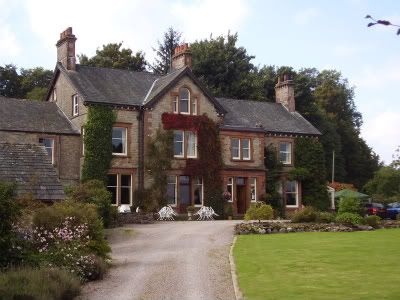 Gary then came in and taught us about 9th chords and arpeggios - all of which we worked through, and together we played "Hotel California" which has an E9 chord and a solo which you can play using the B harmonic minor scale. He also used "House of the Rising Sun" as an example of how to arpeggiate. I'm glad to report that none of us had to refer to the chord sheet for that one! (As if!)
Gary then came in and taught us about 9th chords and arpeggios - all of which we worked through, and together we played "Hotel California" which has an E9 chord and a solo which you can play using the B harmonic minor scale. He also used "House of the Rising Sun" as an example of how to arpeggiate. I'm glad to report that none of us had to refer to the chord sheet for that one! (As if!)After lunch it was time to bid our farewells and make our respective ways back home. All in all, it was an intense course. It was very enjoyable but it was certainly no picnic. (If you go on one of these courses you must be prepared to work!) As I said earlier, the course was much harder than I was expecting and if I'm honest I was slightly outside of my own comfort zone, but then surely it's better to be challenged rather than to cruise through things that come easily.
Guitar Weekends offer a whole host of these intensive weekends for guitarists of all abilities - Strugglers, Improvers, Rock, Blues, Country, Django and Maintenance. Next year they are possibly going to introduce a Recording weekend. I've been on two weekends now (which is nothing compared to some people who keep on coming back for more), and can wholeheartedly comment on their excellence: venue, staff, food, accommodation, material covered - all are top notch. My thanks to Lesley and Malcolm at Beckfoot House and also to our tutor Gary Dunn.
Friday, 26 September 2008
Just stepped out for a few moments... Back soon!
OK guys, I'm taking a short break - and it is guitar-related so I'll tell you all about it when I get back on Monday.
Thursday, 25 September 2008
Outrage as Stratoblogster is Censored!
 Since when did Blogger/Google start censoring our blog posts?
Since when did Blogger/Google start censoring our blog posts? JP Stratoblogster posted a very interesting rant recently which questioned Premier Guitar's apparent habit of giving rave reviews to their advertisers' own products. A review of one guitar in particular, the Etavonni GT-1 - a very expensive and supposedly innovative instrument, made JP think that something very fishy was going on and so he wrote this article (now re-posted).
Then the article was pulled!
Someone didn't like it! Premier Guitar? Etavonni? I don't know, but it seems that JP's comments clearly hit a nerve. Too close to the truth, perhaps? Almsot certainly, I'd say.
Why not respond with their side of the story? Why not enter into the debate in a reasonable, sensible way? Or even admit "Yes, we screwed up..."
Getting the article censored by Google/Blogger is just playing dirty tricks.
UPDATE: Kudos to Premier Guitar for getting involved in this discussion and responding to some of the issues that JP raised. (See the comments both here and on Stratoblogster).
Do you want spiders or pigs on your guitar?
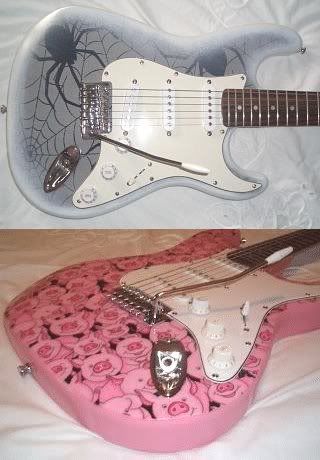 This seller has a bunch of interesting customisations of cheap guitars for sale on eBay right at the moment.
This seller has a bunch of interesting customisations of cheap guitars for sale on eBay right at the moment. Several have fabric-covered bodies which are then lacquered over. I thought that these two examples were quite eye-catching. The spider guitar would probably appeal to many up and coming rockers, but I'm not really sure who'd want to buy the pig guitar.
Unfortunately some of his other customisations are spoilt by his insistence of putting counterfeit Fender logos on the headstock. He's also very cheekily added a Gibson decal to an LP clone. Regular readers will know my thoughts on this practice.
If it's not a Fender/Gibson/Rickenbacker/(whatever) then DON'T put that company's logo on it! It's fraud, plain and simple.
Wednesday, 24 September 2008
The Guitarz September 2008 pick of the guitars on eBay
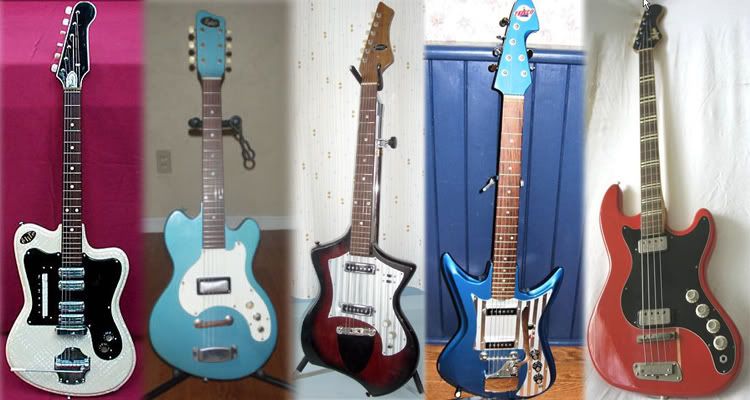
So, pictured above from left to right we have:
- An Italian Elite Crucianelli guitar circa 1964 with immaculate pearloid finish and all hardware present and correct including tremolo arm.
- A Supro (1965-1968), nice simple single-pickup guitar, notoriously good sound for blues and slide.
- A late 60s Kingston Swinger (i.e. re-badged Teisco) in great condition and featuring a very cool and distinctive body shape.
- A Teisco ET-230 in metallic blue - again it's in fantastic condition.
- A Hofner Artist bass, also from the 60s, which not only good but is supposedly very playable too.
Tuesday, 23 September 2008
Nuax Guitars

These guitars aren't cheap, but they are hand-made luthier-built instruments. They also boast bodies and necks built from FSC-certified and handpicked woods coming from well-managed and environmentally audited forests, have multi-radius fretboards, Earvana compensated nut, Gotoh 510 tuners, plus they are fully customizable.
There's a bunch of these on eBay right now, so you could pick up a bargain depending on how the bidding goes.
Monday, 22 September 2008
Guitar with no name
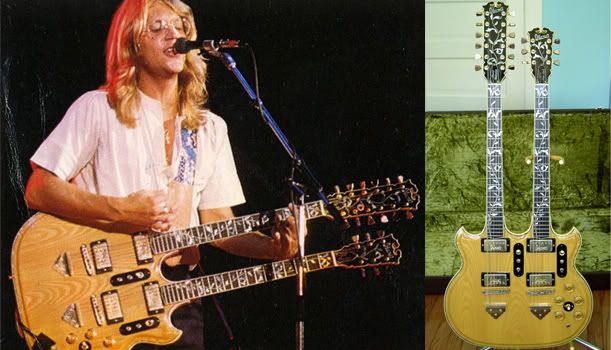
Saturday, 20 September 2008
DVD Review: AC/DC - No Bull (The Director's Cut)
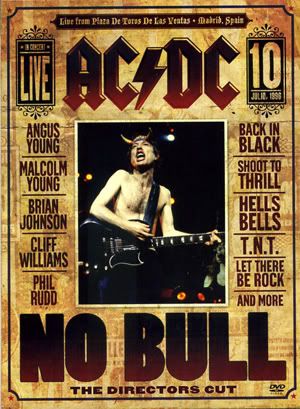 Let's face it, how much reviewing does this DVD need? With a band like AC/DC you know exactly what to expect: good honest, straight-forward rock'n'roll and with that all-important element of fun.
Let's face it, how much reviewing does this DVD need? With a band like AC/DC you know exactly what to expect: good honest, straight-forward rock'n'roll and with that all-important element of fun. The footage on this DVD was filmed at the Plaxa De Toros De Las Ventas bullfighting arena in Madrid on the Ballbreaker tour in 1996, and was originally released to video shortly after. The director David Mallet was never happy with the results and so for this new DVD edition the film has been completely re-edited in HD and the audio remixed in both Stereo and 5.1 Surround Sound.
The results are quite spectacular, it has to be said. For starters, the venue is amazing (introducing "Hail Caesar", singer Brian Johnson comments that its the perfect setting for that song), the picture is crystal clear, there are seemingly cameras EVERYWHERE so that we get viewpoints from all over the place, and the band appear to be on top form too.
I approached this video as someone who was not a fan of the band as such, although I bear them no malice, they were just a band I'd never followed. Let's just say, I've been converted. I would have loved to have been at this show, to have seen the spectacle and have witnessed the band working their arses off!
The rhythm section - Malcolm Young on rhythm guitar, Cliff Williams on bass and Phil Rudd on drums - are AD/DC's secret weapon. Those guys are so tight and together they form the powerhouse that drives the whole band along. Brian Johnson's vocals at times resemble a strangled croak, but so what? - it suits the songs - and he has the capability to produce a dirty bluesy growl on songs like "Boogie Man".
Obviously the star of the show is the SG-wielding lead guitarist Angus Young. He is just incredible, and I marvelled at how he could play a guitar solo with apparent ease whilst bombing about from one side of the stage to the other like a demented toddler. His now legendary school uniform only lasted until seven songs into the set, when he interrupted his own guitar solo in order to perform a strip tease. Now that's not the kind of entertainment you get from the likes of Eric Clapton.
There was a fair amount of OTT theatricality to this show what with giant demolition balls, Brian Johnson swinging from the clapper of a giant bell Quasimodo-stylee ("Hells Bells"), cannons firing into the audience ("For Those About To Rock (We Salute You)"), and a monolithically pneumatic Rosie making an appearance in "Whole Lotta Rosie". Somehow all this fails to detract from the band just blasting out their own brand of riff-tastic rock'n'roll. After all, the venue's big enough for all of this.
What more can I say? I think this is the kind of thing that you're either going to love or you're going to hate. I thought it was fantastic, but all the fans are going to buy it anyway. All the big hits are there. It's well-directed, well-produced. I think it's a winner.
At two hours for the main feature I'd say it was good value for money too. Additionally the special features include a couple of bonus performances from other shows on the same tour - these renditions seem somehow rawer to my mind, and are intriguing when contrasted with the Madrid show. Then there are also the alternate "Angus-cam" versions of four songs from the Madrid show, for those of you who'd like to study his technique on a Gibson SG guitar or else to copy his trademarked "spasm".
Buy it here.
Friday, 19 September 2008
Gottschall Funnel-Bodied and Double-Sided Guitars
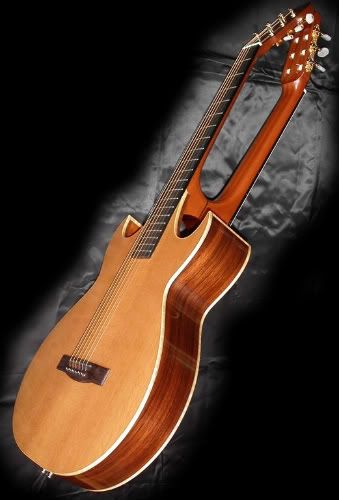 Here's one from the Guitarz archives.
Here's one from the Guitarz archives.Germany's Gottschall Guitars build acoustics with their patented twin-cutaway funnel body design. Sideways on, the body of the guitar is tapered towards the neck. The insides of the twin cutaways are left open and function as the guitar's soundholes. This allegedly has the effect of increasing the loudness of the guitar by +3 dB.
The guitar pictured is a varition on the doubleneck guitar, it's a double-sided guitar with a nylon-strung guitar on one side and a steel-strung guitar on the other.
The double-sided guitar is not an altogether unique idea. Guitarist Thom Bresh uses a double-sided guitar - The Bresh Dualette - built by Langejans Guitars. This is priced on the Langejans website at $12,995.
Of course, if you can't afford that, Kevin Siebold of Krappy Guitars could build you a "Flipitar" - a double-sided electric - for considerably less.
Thursday, 18 September 2008
MEG Transformer Guitar
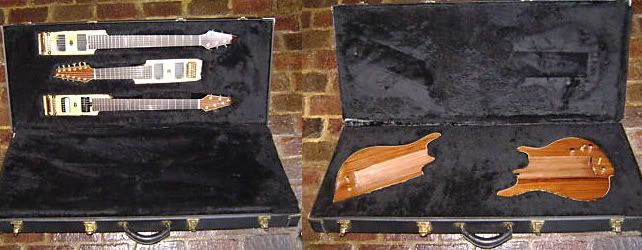
To quote from the eBay listing:
"There's only one MEG Transformer. There’s never been anything like it before, and there will never be anything like it again. The product of over 20,000 total man hours, it's destined to be the last machine prototype of MEG research and development.
The MEG Transformer is the most mechanically advanced guitar on the planet. It assumes the character of single or double neck, with the choice of multiple string configurations using three universally adaptable necks: standard six, baritone and octave twelve. The standard six has an ABM hardtail with roller saddles on a Tune-a-matic style bridge. The sustain is enhanced by the MEG design; the baritone is tuned four steps lower than the six string and has the characteristic big voice that is great for a bedrock sound; the octave 12 is an amazing experience - it has a sound comparable to an autoharp, zither or dulcimer - and it's tuned like a guitar."

Wednesday, 17 September 2008
Sorry, but what's it got to do with Tony Zemaitis?
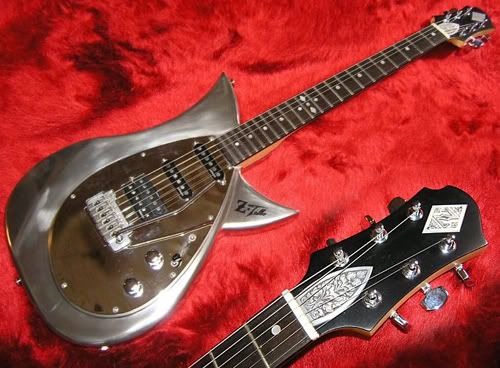
Now, don't get me wrong, I think this aluminium-bodied Tokai 'Zemaitis" Talbo is a really tasty looking guitar, but why tag on the totally spurious Zemaitis connection?
The late Tony Zemaitis created some amazing high quality "boutique" guitars, and was quite an innovator with distinctive designs such as his engraved metal fronts and pearl mozaic tops. (See the Official Zemaitis Guitar Owners Club website).
I was alarmed a couple of years ago when the Japanese appropriated his name and began making faithful replicas (see www.zemaitis.net). They are high-quality replicas, but personally I find the idea of putting them out under the "Zemaitis" banner a little bit tasteless.
Now this Tokai Talbo is one step further away again. It's a Tokai Talbo (which always was a metal-bodied guitar) but with a Zemaitis-shaped headstock. As far as I am aware there is no genuine Tokai/Zemaitis connection so, again, this seems improper.
A fine guitar, but why cash in unnecessarily on the late Tony Zemaitis' name?
Tuesday, 16 September 2008
Now that's what I call an optimistic eBayer
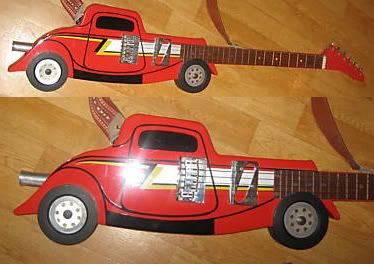 The seller of this home-made ZZ Top car guitar is asking a staggering 500 Euros for it! (That's £396 or $708).
The seller of this home-made ZZ Top car guitar is asking a staggering 500 Euros for it! (That's £396 or $708).As if that wasn't bad enough, it's not even a functioning guitar! It's just a "decorative item".
(Interesting use of a Telecaster bridge, don't you think?)
Monday, 15 September 2008
Yamaha EZ-EG digital guitar
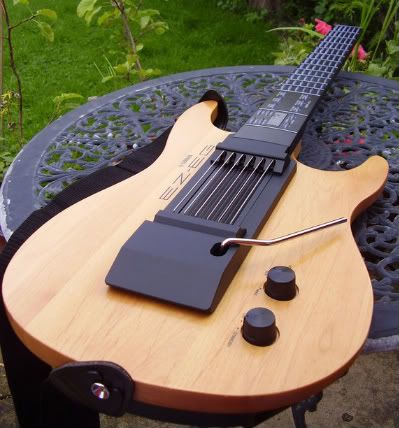 Here's something that I've been playing about with over this last week. Now I've seen these "guitars" before and had always written them off as being toy-like. However, having read a few reviews and followed some discussions on forums, I decided that I'd like to try one out. Although it was designed as a basic learning instrument (the idea being that the learner can play along to songs with a backing track whilst being guided by chord shapes that light up on the "fretboard"), the fact that it is MIDI-equipped makes it really quite interesting.
Here's something that I've been playing about with over this last week. Now I've seen these "guitars" before and had always written them off as being toy-like. However, having read a few reviews and followed some discussions on forums, I decided that I'd like to try one out. Although it was designed as a basic learning instrument (the idea being that the learner can play along to songs with a backing track whilst being guided by chord shapes that light up on the "fretboard"), the fact that it is MIDI-equipped makes it really quite interesting.I found a seller from Japan on eBay who seemed to be shifting a fair few of these, and the price wasn't too prohibitive, so I thought I'd give it a whirl. Last Monday I arrived home to find that it had been delivered - and all without having to pay the expected custom charges (although perhaps I should keep quiet about that).
Getting it out of the box my first impression was of how toy-like it looked. The wooden body is a nice touch, but much of the rest of it is plasticky and flimsy-looking. The wooden portion of the body is only a thin slice sandwiched between two layers of plastic housing parts for the electronics. I mean, look at the back of this instrument, it's hardly neat is it? It would have been so much nicer if all the electronics could have been housed inside a wooden body. It needn't cost that much to produce. Bear in mind that Yamaha also produce the cheap and cheerful (and excellent value-for-money) Pacifica 112 guitars which have solid wood bodies.
The plastic neck also is very insubstantial. When playing the "guitar", I was aware that I was bending the neck when playing certain chords. Again I wonder if the back of the neck couldn't have been made from wood.
Another gripe is that on my model the tremolo arm seems to be totally knackered. Unfortunately this guitar was sold as seen, and even if it wasn't any return postage to Japan would make this a much more expensive experiment.
On plugging in and turning it on I soon found out that the internal speaker beneath the "strings" on the body is absolutely rubbish. Every sound I tried selecting was distorted and quite unlistenable. Oh dear, so far NOT so good.
Next I plugged in headphones. Now, that's better!
Now this "guitar" doesn't actually have any strings as such. It has buttons for each of the fret positions on six strings up to the twelth fret, and for the right hand it has six plastic bars which can be picked, plucked or strummed. I was surprised at how quickly I was able to find my way around using this system. In its favour, it does feel like you are playing a real stringed guitar. The fretboard buttons are shaped as if they are small sections of string, and the right hand "strings" are actually quite responsive. Keying the left-hand string-buttons will start up the relevant note(s) but quietly as if hammering on with the left hand on a real guitar. You need to strike the right hand "strings" to get any real attack to a note.
Obviously with the string-buttons you can't perform string bends so no chance of any expression there, but you are allowed quite a lot of expression with the right hand as those bars seem very responsive. They are certainly responsive in terms of volume, in how hard or softly you play the strings.
I suppose the other way of injecting a bit of expression would be through use of the whammy bar, but that's a no-no on this particular example.
There are twenty on-board sounds. A classical guitar, steel-strung guitar, twelve string, several basses, banjo, etc. Some sounds are better than others (the banjo's quite good), and the bass sounds are better when you drop the whole instrument down an octave using the tuning function. The 12-string sound raised an octave gives quite a nice mandolin sound.
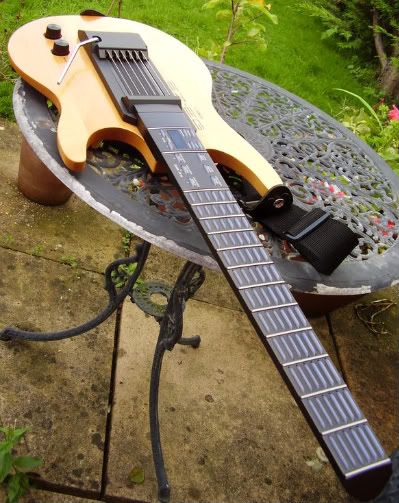 Did I mention that the string-buttons on the "fretboard" light up as you play them?. Although this was conceived as a learning aid and might seem a little cheesy, it's still quite useful because it highlights where you are playing sloppy chords, perhaps where one finger is straying slightly onto a string where it shouldn't, which I'm sure I do quite a lot. So, it discourages sloppy playing, which is surely a good thing.
Did I mention that the string-buttons on the "fretboard" light up as you play them?. Although this was conceived as a learning aid and might seem a little cheesy, it's still quite useful because it highlights where you are playing sloppy chords, perhaps where one finger is straying slightly onto a string where it shouldn't, which I'm sure I do quite a lot. So, it discourages sloppy playing, which is surely a good thing.So things are getting more interesting, but it's still limited in what it can do.
Next I dug out my old Yamaha QY-20 sequencer and connected the guitar with MIDI cables. Now the cables were quite short at only two metres so I made a mental note not to go walkabout while playing. (I doubt I'd ever want to play this in a performance, so no worries about running about the stage and not having a long enoguh MIDI cable).
I used to use the QY20 quite a few years ago when recording songs. I'd spend ages programming it, but rarely entered any tracks in real time as I'm not too familiar with a keyboard layout and also the keyboard on this thing is tiny and made of rubber. How great would it be to be able to use a controller laid out like a guitar fretboard, something that I'm familiar with.
The guitar hadn't come with a manual so there ensued a session of trial and error trying to get the guitar to communicate with the QY-20. For ages it seemed that nothing was working, then I realised that I had a synth sound from the QY-20 on the high E-string.
With just one string working I tried out a few QY-20 sounds. Some worked better than others. Not everything sounds great with the kind of attack you get from plucked strings. I particularly liked some of the more tuned percussion sounds such as vibes and xylophone.
It took me a while to work out how to get all the other strings working. The QY-20 is an 8-track sequencer. What the MIDI was doing was assigning one "string" of the guitar to each of the first six channels of the QY-20. I found it somewhat tedious having to dial in the same sound to each of the six channels just to try out a synth sound across the whole guitar, but I soon realised that this system had its advantages too. For example, I could assign different synth sounds to different strings. This sounded quite interesting with sax sounds where I could put a baritone sax sound on the low E and A, tenor sax on D and G, and alto sax on B and high E.
Another trick was that I was able to pan each string to a different position in the stereo spectrum. Neat!
Now I was beginning to get ideas... But, these are going to have to wait for now as I want to experiment some more. I think the real test will be to record a song using this instrument.
Stay tuned...
Sunday, 14 September 2008
Born To Rock bass
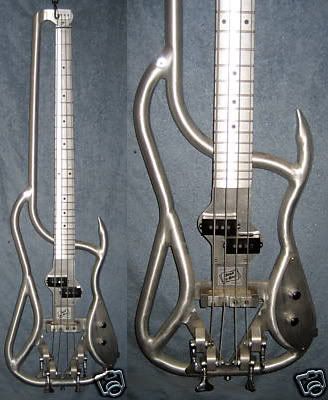 This skeletal looking Born To Rock bass is an odd one. The body is made of aluminium tubing, whilst the neck is wood but fronted with an aluminium fretboard. This was made circa 1995 and I'm guessing it's quite rare as you don't see these too often. Actually, I've never seen one before. I wonder if it was a production instrument or just a one-off? It does have a home-made quality to it. The bar connecting the end of the neck to the body puts me in mind of Roland's 707 synth controller. Apparently the idea is to eliminate deadspots.
This skeletal looking Born To Rock bass is an odd one. The body is made of aluminium tubing, whilst the neck is wood but fronted with an aluminium fretboard. This was made circa 1995 and I'm guessing it's quite rare as you don't see these too often. Actually, I've never seen one before. I wonder if it was a production instrument or just a one-off? It does have a home-made quality to it. The bar connecting the end of the neck to the body puts me in mind of Roland's 707 synth controller. Apparently the idea is to eliminate deadspots.UPDATE: BigRedX has pointed me in the direction of borntorock.com. One of the most interesting features of these guitars and basses is unique system they use to replace the traditionally used trussrod. To quote the website, "Suspending the neck on pivots allows the strings to position the neck. A string under tension defines a straight line. Since the strings are straight, so is the neck."
It's interesting to note that in the Care and Maintenance section the following method of string changing is recommended: "Lay the guitar flat on a table. Remove the strings and clean the neck with a paper towel. Don't use abrasive cleaners. Make sure not to pull on the neck when the strings are off, because it is attached only by the pickup wires. Restring in the following order, for greatest convenience: 6,1,5,2,4,3."
Friday, 12 September 2008
'60s Bruno Guitar from Japan
 This cheesy old Japanese guitar bearing the Bruno brand name was possibly supposed to have a hollow-bodied Mosrite vibe, but to me it looks like a Gibson 335 has been given the Brian Eastwood Distortocaster treatment.
This cheesy old Japanese guitar bearing the Bruno brand name was possibly supposed to have a hollow-bodied Mosrite vibe, but to me it looks like a Gibson 335 has been given the Brian Eastwood Distortocaster treatment.Speaking of which, Guitarz reader Johnny was the eventual buyer of the Distortocaster that we featured recently, and you might be glad to hear that he's removed the dolphin!
Wednesday, 10 September 2008
Internal Combustion Guitar: A New Kind of Guitar?
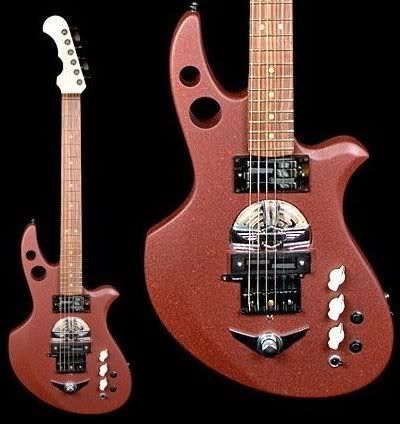 When I first looked at Woody B's Internal Combustion Guitar website I couldn't quite figure out what I was looking at. Was it absolute genius or completely bonkers?
When I first looked at Woody B's Internal Combustion Guitar website I couldn't quite figure out what I was looking at. Was it absolute genius or completely bonkers? Viewing the videos the picture does become clearer, but I don't think these convey the full potential of this instrument. It seems the concept behind the guitar is to recreate the effect of playing in front of a bank of Marshall amps and finding that "sweet spot" where your guitar resonates with the power of the amps and enables you to execute some blistering guitar playing - BUT - without the extreme volume and need for a bank of Marshalls.
As Woody B, who would seem to be the creator of this beast, says: "It's the guitar you don’t just play... you actually feel the ride!"
From what I can work out what happens is that the guitar has a "driver pickup" mounted near the bridge. The signal from this is fed out to a small low-wattage amp, and then back into the guitar which has its own resonance chamber and speaker. This has the effect of bringing the guitar to life with its own resonance and sustain which can then be tuned with a pot to the rear of the bridge. The neck pickup - one of Lace's very tasty alumitone units - then captures the sound of the whole and sends it through to your main amp. Or alternatively, you can use the hex pickup on the midi-capable V12 model to send to synth equipment.
It's a very intriguing instrument, and puts me in mind of the new Moog guitar with its various sustain modes.
One feature it does have in common with the Moog guitar is a particularly hefty price tag. If I had the necessary money I think I'd be hard pushed which to buy: the Moog or the Internal Combusion Guitar. I certainly prefer the Internal Combusion Guitar when it comes to aesthetics and part of me suspects that it may have more "mojo" (if I'm allowed to use that word!).
In summary: very interesting. I'd like to see and hear more.
UPDATE: Read the Comments for more on this guitar from Woody B himself.
Monday, 8 September 2008
Bedpan guitar
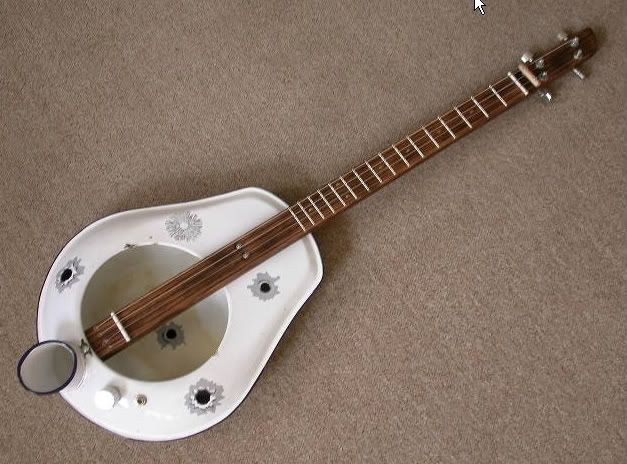
I'm not quite sure what the deal is with the fake bullet holes.
Sunday, 7 September 2008
T.F. Elliott White Dove Guitar - The Mosrite That Never Was
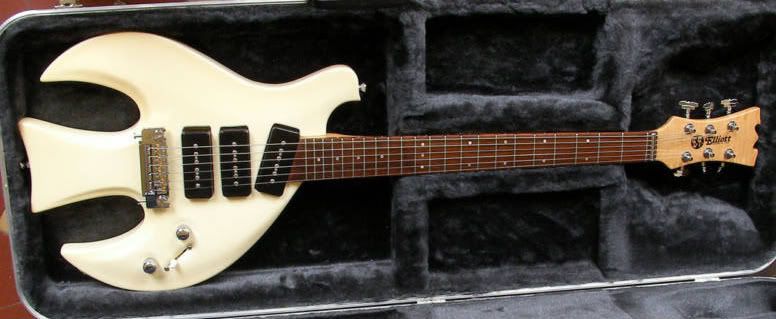
Saturday, 6 September 2008
Buying a guitar in the UK?
 Guitar123.co.uk is a nifty little price comparison site for anyone in the UK (or Europe even) who is thinking of buying a guitar. They've rounded up the most popular electric, acoustic, electro-acoustic and bass guitars from many of our favourite brands and allow you to see easily on one screen which online-retailers are stocking your chosen instrument and at what prices.
Guitar123.co.uk is a nifty little price comparison site for anyone in the UK (or Europe even) who is thinking of buying a guitar. They've rounded up the most popular electric, acoustic, electro-acoustic and bass guitars from many of our favourite brands and allow you to see easily on one screen which online-retailers are stocking your chosen instrument and at what prices.Obviously they don't have the info for every model of guitar you can think of, but all the most popular models are there and I feel this site would be of benefit to those choosing their first guitar or else upgrading from a basic instrument.
Bear in mind also that it would be near impossible to cover all retailers, but those that are listed are some of the bigger retailers and the ones that usually are able to make the best price offers.
Hendrix's burnt Strat sells for £280,000
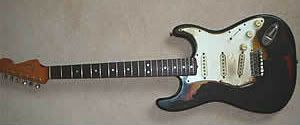 This Fender Stratocaster which was set alight as a publicity stunt by Jimi Hendrix during a concert at London's Astoria in March 1967 has been auctioned off for £280,000 ($595,000) to a collector in the US. The successful bidder Daniel Boucher is quoted as saying "I thought I'd have to pay a little bit more for it, actually. I am going to play it, I hope some of it rubs off on me."
This Fender Stratocaster which was set alight as a publicity stunt by Jimi Hendrix during a concert at London's Astoria in March 1967 has been auctioned off for £280,000 ($595,000) to a collector in the US. The successful bidder Daniel Boucher is quoted as saying "I thought I'd have to pay a little bit more for it, actually. I am going to play it, I hope some of it rubs off on me."So, it didn't make the speculated $1million.
Check out this footage of a BBC reporter playing the guitar.
Friday, 5 September 2008
Japanese Ardley Playmate guitar
 Here's an obscure Japanese guitar from a brand that I've never encountered before. Sporting a rather unusual body shape, this Ardley Playmate is finished in bright orange and with a blue perspex scratchplate. I'm guessing this would have been from the late 1970s or early 1980s. Despite its peculiar shape and judging by the pickups installed I'd imagine it'd sound something like a Telecaster. But the weird shape and colour scheme beg the question: Who would use a guitar like this? I can imagine an 80s-style electro band, or perhaps a quirky band in the Devo mold. What do you think? And have you ever seen one like this before or have you heard of this brand?
Here's an obscure Japanese guitar from a brand that I've never encountered before. Sporting a rather unusual body shape, this Ardley Playmate is finished in bright orange and with a blue perspex scratchplate. I'm guessing this would have been from the late 1970s or early 1980s. Despite its peculiar shape and judging by the pickups installed I'd imagine it'd sound something like a Telecaster. But the weird shape and colour scheme beg the question: Who would use a guitar like this? I can imagine an 80s-style electro band, or perhaps a quirky band in the Devo mold. What do you think? And have you ever seen one like this before or have you heard of this brand?
Thursday, 4 September 2008
Strobel Guitars - The Guitar That Fits In A Briefcase
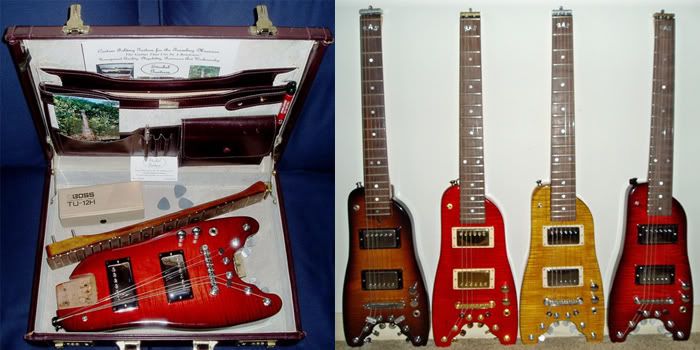
Wednesday, 3 September 2008
Guitare de Voyage
 You know how I love featuring weird guitar designs on this blog. Here's a very strange-looking electro-acoustic travel guitar being offered from a seller in Canada. Unfortunately, the seller doesn't supply very much information so the photo is all we have to go on.
You know how I love featuring weird guitar designs on this blog. Here's a very strange-looking electro-acoustic travel guitar being offered from a seller in Canada. Unfortunately, the seller doesn't supply very much information so the photo is all we have to go on.
Country Music's "Guitar Man" Jerry Reed dies at age 71
The Grammy award-winning session and tour guitarist Jerry Reed has died at the age of 71. As well as playing with Chet Atkins, Joan Baez and Ringo Starr, writing songs for Johnny Cash, Elvis Presley and Brenda Lee, Jerry Reed also found time to be an actor, and famously appeared alongside Burt Reynolds as The Snowman in the Smokey and the Bandit movies.
Tuesday, 2 September 2008
Kevin Deane Guitars - Ireland
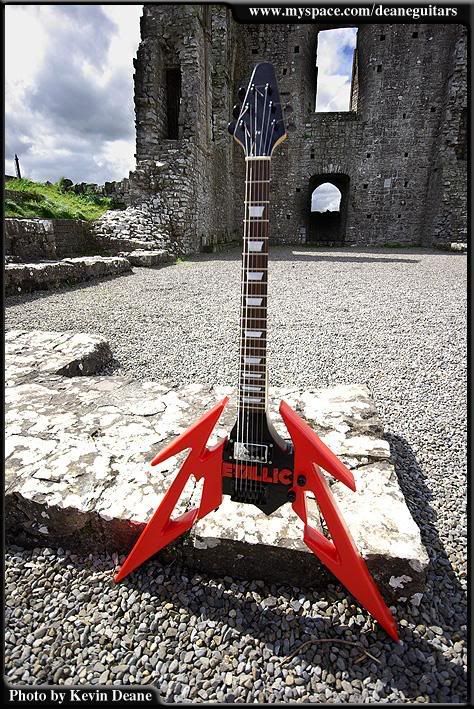 I suppose one of the things I'm (in)famous for on this blog is trawling eBay for weird and wonderful guitars, but of course eBay isn't my one and only source. I found Kevin Deane Guitars over on MySpace and I was mightily impressed with what I saw.
I suppose one of the things I'm (in)famous for on this blog is trawling eBay for weird and wonderful guitars, but of course eBay isn't my one and only source. I found Kevin Deane Guitars over on MySpace and I was mightily impressed with what I saw.Kevin has come up with some amazing designs, some of which are based on band logos. You should see the guitars he has made for a-ha and The Corrs - very intricate!
His most recently finished project is the Metallica guitar pictured here. The design of the guitar is based on the original Metallica logo which appears on the "Kill Em All" album. Kevin noticed that the shape of the logo wasn't too far away from a Flying V.
The wood used for the body is Maple ply. Kevin explains that the use of ply adds extra strength to the unusual shape and that it is also very dense in structure with no voids. (I'm reminded of the Abba "star" guitar - its creator Goram Malmberg told me that it was built from ply so the the edge of the horns would not break).
Kevin explains that this guitar is the prototpye, and that he plans to build three more: "One will stay here in my collection and two will go to other places in the world... I'm not sure where or how yet, but I'm hoping it will be places that Metallica fans can see them, play them, or use them!"
Let's hope that Metallica themselves get to see his work. I'm sure we'd all love to hear what they think of Kevin's work.
Kevin is now working on a Metallica Ninja logo bass, the design of which looks fantastic. I'm looking forward to seeing the finished item.
(Photo used with permission).
